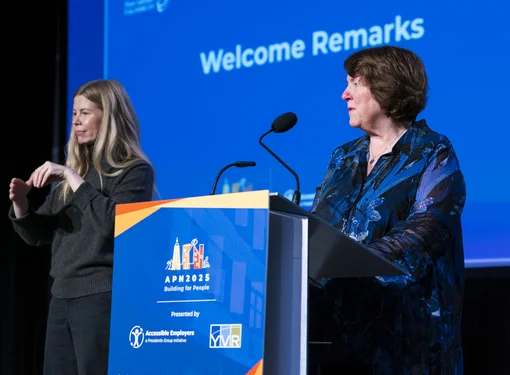Access to play
Research and studies have consistently proven what we all know to be true – play is vital for childhood development. During our times on playgrounds, we learn about how our bodies work, how the world functions around us, and develop social skills.
But what happens when a playground is not accessible?
 Above image: This playground in Mississippi has wood chip flooring and stairs that can affect mobility devices. While it is "ADA accessible," these barriers prevent it from being fully accessible.
Above image: This playground in Mississippi has wood chip flooring and stairs that can affect mobility devices. While it is "ADA accessible," these barriers prevent it from being fully accessible.
Traditionally, playgrounds have emphasized physical ability, with swings, monkey bars, slides, and so forth. One key component that is associated with those features is climbing.
As a result, children who have mobility impairments may be left to linger at ground level while their peers dash and run to places where wheelchairs and walkers cannot access. Even for children who use leg braces, there may be other deterrents such as uneven ground.
According to research by Karen E. Diamond of Purdue University and Soo-Young Hong of the University of Nebraska – Lincoln, young children go through a phase of seeing themselves and others, which includes how to identify oneself as part of the community.
When children with disabilities are only able to play separately, it may cause a feeling of being "different," which fuels exclusion – and that makes the social isolation worse.
Children also develop a sense of spatial awareness through the use of playground equipment (in addition to physical fitness benefits). By depriving children with disabilities full access to play, that development can be compromised.
 A wheelchair accessible swing set in Tsawwassen, British Columbia, where children with and without disabilities can play together.
A wheelchair accessible swing set in Tsawwassen, British Columbia, where children with and without disabilities can play together.
In recent years, the number of accessible playgrounds has grown. New building standards are being introduced, with new features. These features include:
These playgrounds also benefit parents with disabilities. For example, a parent who uses a wheelchair may have to rely on others to push his/her son on a swing if the playground is inaccessible. However, with an accessible playground, he/she can do that, as well as tend to the child when needed.
It also benefits parents with children still using strollers, since the strollers can easily be rolled on – ideal for those who may have young children and infants!
 Above image: Morgan's Wonderland in San Antonio, Texas is known as the world's first "ultra-accessible" playground and amusement park, and features a wheelchair accessible train ride. (Photo by Colleen Pence, licensed via CC-BY-2.0)
Above image: Morgan's Wonderland in San Antonio, Texas is known as the world's first "ultra-accessible" playground and amusement park, and features a wheelchair accessible train ride. (Photo by Colleen Pence, licensed via CC-BY-2.0)
Recently, NPR released a website about accessible playgrounds. On there, you can find tips for building or planning such playgrounds, as well as a user-generated database of universal designed play areas in the United States.
The Rick Hansen Foundation was also part of a program called Let's Play, which pushed for accessible playgrounds in British Columbia.
In San Antonio, the world's first "ultra-accessible" playground and amusement park opened – Morgan's Wonderland was established to be welcome to all, and includes a train ride, gymnasium, water park, and more.
There are still challenges such as costs; however, as with other markets, that may change as demand increases.
But what happens when a playground is not accessible?
The problem
 Above image: This playground in Mississippi has wood chip flooring and stairs that can affect mobility devices. While it is "ADA accessible," these barriers prevent it from being fully accessible.
Above image: This playground in Mississippi has wood chip flooring and stairs that can affect mobility devices. While it is "ADA accessible," these barriers prevent it from being fully accessible.
Traditionally, playgrounds have emphasized physical ability, with swings, monkey bars, slides, and so forth. One key component that is associated with those features is climbing.
As a result, children who have mobility impairments may be left to linger at ground level while their peers dash and run to places where wheelchairs and walkers cannot access. Even for children who use leg braces, there may be other deterrents such as uneven ground.
The impact
According to research by Karen E. Diamond of Purdue University and Soo-Young Hong of the University of Nebraska – Lincoln, young children go through a phase of seeing themselves and others, which includes how to identify oneself as part of the community.
When children with disabilities are only able to play separately, it may cause a feeling of being "different," which fuels exclusion – and that makes the social isolation worse.
Children also develop a sense of spatial awareness through the use of playground equipment (in addition to physical fitness benefits). By depriving children with disabilities full access to play, that development can be compromised.
The solution
 A wheelchair accessible swing set in Tsawwassen, British Columbia, where children with and without disabilities can play together.
A wheelchair accessible swing set in Tsawwassen, British Columbia, where children with and without disabilities can play together.
In recent years, the number of accessible playgrounds has grown. New building standards are being introduced, with new features. These features include:
- Wheelchair and mobility friendliness:
- ramps rather than stairs
- rubber flooring rather than wood chips or gravel
- lowered play items to reach from sitting level
- elevated sandboxes with leg and knee space
- roll-on swing sets
- Hearing friendliness:
- sound play elements
- sign language games (such as finger-spelling displays)
- clear visibility with few solid walls or dividers
- Blind friendliness:
- distinct colours with high contrast
- shades chosen to accommodate colour-blindness
- Braille displays
- no tripping hazards
- General:
- fences around the playground to prevent children wandering away or to help avoid dangerous areas
- swing sets with seats that incorporate seat belts and and lateral supports: great for those with poor balance
- play items that children with and without disabilities can use together
It is about the parents too
These playgrounds also benefit parents with disabilities. For example, a parent who uses a wheelchair may have to rely on others to push his/her son on a swing if the playground is inaccessible. However, with an accessible playground, he/she can do that, as well as tend to the child when needed.
It also benefits parents with children still using strollers, since the strollers can easily be rolled on – ideal for those who may have young children and infants!
Things are changing
 Above image: Morgan's Wonderland in San Antonio, Texas is known as the world's first "ultra-accessible" playground and amusement park, and features a wheelchair accessible train ride. (Photo by Colleen Pence, licensed via CC-BY-2.0)
Above image: Morgan's Wonderland in San Antonio, Texas is known as the world's first "ultra-accessible" playground and amusement park, and features a wheelchair accessible train ride. (Photo by Colleen Pence, licensed via CC-BY-2.0)
Recently, NPR released a website about accessible playgrounds. On there, you can find tips for building or planning such playgrounds, as well as a user-generated database of universal designed play areas in the United States.
The Rick Hansen Foundation was also part of a program called Let's Play, which pushed for accessible playgrounds in British Columbia.
In San Antonio, the world's first "ultra-accessible" playground and amusement park opened – Morgan's Wonderland was established to be welcome to all, and includes a train ride, gymnasium, water park, and more.
There are still challenges such as costs; however, as with other markets, that may change as demand increases.







